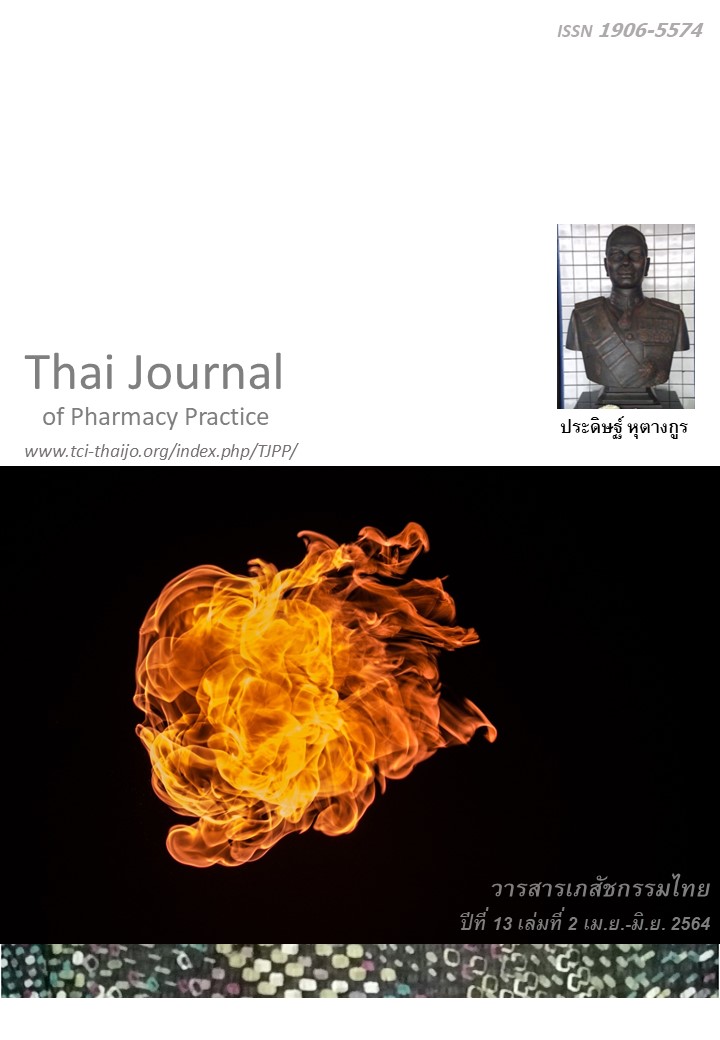ปัจจัยที่ส่งผลต่อพฤติกรรมการใช้ยาฉีดอินซูลินในผู้ป่วยเบาหวานชนิดที่ 2 โรงพยาบาลลอง อำเภอลอง จังหวัดแพร่
Main Article Content
บทคัดย่อ
วัตถุประสงค์: เพื่อศึกษาพฤติกรรมการใช้ยาฉีดอินซูลิน (Insulin Injecting Behaviors: IIB) และปัจจัยที่ส่งผลต่อ IIB ในผู้ป่วยโรคเบาหวานชนิดที่ 2 (type 2 diabetes mellitus: T2DM) โรงพยาบาลลอง อำเภอลอง จังหวัดแพร่ วิธีการ: การศึกษาครั้งนี้เป็นการวิจัยภาคตัดขวางเชิงวิเคราะห์ ซึ่งเก็บรวบรวมข้อมูลโดยใช้แบบสอบถาม ตัวอย่าง คือ ผู้ป่วย T2DM 264 คนที่เข้ารับการตรวจรักษาในคลินิกโรคเบาหวานแผนกผู้ป่วยนอก โรงพยาบาลลอง จังหวัดแพร่ การเลือกตัวอย่างใช้วิธีการสุ่มตัวอย่างแบบเป็นระบบ การศึกษาประเมิน IIB โดยใช้แบบสอบถามชนิดตอบด้วยตนเอง ตัวแปรตามในงานวิจัยคือ IIB ตัวแปรต้นคือ ปัจจัยส่วนบุคคล ปัจจัยด้านยารักษาโรคเบาหวาน การรับรู้สมรรถนะแห่งตนต่อการใช้ยาฉีดอินซูลินและการได้รับแรงสนับสนุนทางสังคมของผู้ป่วย T2DM ผลการวิจัย: ตัวอย่างร้อยละ 66.3 มีคะแนน IIB อยู่ในระดับปานกลาง ปัจจัยที่ส่งผลต่อ IIB มากที่สุดได้แก่ ระดับน้ำตาลในเลือด (β = -0.588, P < 0.001) รองลงมาคือการได้รับแรงสนับสนุนทางสังคม (β = 0.270, P < 0.001) การรับรู้สมรรถนะแห่งตน (β = 0.129, P = 0.009) และเพศชาย (β = 0.076, P=0.032) ตามลำดับ สรุป: บุคลลากรทางการแพทย์ควรส่งเสริมให้ผู้ป่วย T2DM ได้รับแรงสนับสนุนทางสังคม เกิดการรับรู้สรรถนะแห่งตน เพื่อส่งเสริมให้มี IIB ที่ดีขึ้น และควรติดตามการใช้ยาฉีดอินซูลินในผู้ป่วยที่มีระดับน้ำตาลในเลือดสูง รวมทั้งผู้ป่วยเพศหญิงอย่างใกล้ชิด
Article Details
ผลการวิจัยและความคิดเห็นที่ปรากฏในบทความถือเป็นความคิดเห็นและอยู่ในความรับผิดชอบของผู้นิพนธ์ มิใช่ความเห็นหรือความรับผิดชอบของกองบรรณาธิการ หรือคณะเภสัชศาสตร์ มหาวิทยาลัยสงขลานครินทร์ ทั้งนี้ไม่รวมความผิดพลาดอันเกิดจากการพิมพ์ บทความที่ได้รับการเผยแพร่โดยวารสารเภสัชกรรมไทยถือเป็นสิทธิ์ของวารสารฯ
เอกสารอ้างอิง
Sae-lim O. Diabetes mellitus. In: Ninsananda T, Montakantikul P, Wanakamanee U, Suansanae T, Thong-Im J, editors. Textbook of family pharmacist. 4th ed. Bangkok: The Association of Hospital Pharmacy (Thailand); 2014. p.451-66.
Sunthonyothin S, Buranasapkhachon P. Diabetes mellitus. 2nd ed. Bangkok: Chulalongkorn University Printing House; 2013.
International Diabetes Federation. IDF diabetes atlas. 7th ed. [online] 2015 [cited Oct 3, 2016]. Available from: www.diabetesatlas.org.
Phrae Provincial Public Health Office. Information for service plan guideline in NCD DM, HT, and CVD. [online] 2016 [cited May 1, 2017]. Available from: pre.hdc.moph.go.th/hdc/reports/page.php?cat_id=b2b59e64c4e6c92d4b1ec16a599d882b.
Diabetes Association of Thailand. Clinical practice guideline for diabetes 2017 [online] 2017 [cited Jan 5, 2018]. Available from: www.dmthai.org/index.php /knowledge/healthcare-providers/cpg/443-guideline-diabetes-care-2017.
Jiamjarasrangsi W. The health determinants of type 2 diabetes. In: Jiamjarasrangsi W, editors. Type 2 diabetes mellitus protection and self-management support. Bangkok: Chulalongkorn University Printing House; 2018. p.17-32.
Sarinnaphakon W. Seven habits of DSME part 3: Taking medicine.In:Sarinnaphakon W, editors. Treat ment of difficult diabetic patients. Bangkok: Bangkok Wetchasan Printing House; 2014. p.60.
American Diabetes Association. Standards of medical care in diabetes-2014. Diabetes Care 2014; 37 (Suppl 1): S14-80.
Cramer JA, Pugh MJ. The influence of insulin used on glycemic control: how well do adults follow prescriptions for insulin? Diabetes Care 2005; 28: 78-83.
Cheyoe N. Prevalence and predictors of insulin non adherence in T2DM. Journal of Health Systems Research 2016; 10: 333-9.
Polonsky WH, Fisher L, Guzman S, Villa-Caballero L, Edelman SV. Psychological insulin resistance in patients with type 2 diabetes: the scope of the problem. Diabetes Care 2005; 28: 2543-5.
Awodele O, Osuolale JA. Medication adherence in type 2 diabetes patients: study of patients in Alimosho General Hospital, Igando, Lagos, Nigeria. Afr Health Sci 2015; 5: 513-22.
Van BK, Pedersini R, Rooney J, Corrigan SM. Behaviours, thoughts and perceptions around mealtime insulin usage and wastage among people with type 1 and type 2 diabetes mellitus: A cross-sectional survey study.Diabetes Res Clin Pract 2017 ; 126: 30-42.
Prommaloon S, Wattanakitkrileart D, Charoenkitkarn V, Peerapatdit T. Factors Influencing Insulin adherence in patients with type 2 diabetes. Journal of Nursing Science 2017; 35: 61-71.
Sittikankaew K, Navicharoen R. Factors related to health promoting behaviors of type 2diabetes patients with insulin and oral agent therapy. Journal of the Police Nurses 2014; 6: 102-12.
Peyrot M, Barnett AH, Meneghini LF, Schumm-Drae ger PM. Insulin adherence behaviours and barriers in the multinational global attitudes of patients and physicians in insulin therapy study. Diabet Med 2012 ; 29: 682-9.
Ponrak R. Effects of self-efficacy enhancing program on insulin-penfilled injection competency and blood sugar level in elderly with diabetes mellitus. [master thesis]. Songkhla: Prince of Songkla University; 2014
Khlaihong W, Jitramontree N, Wirojratana V. Factors predicting medication adherence behaviors among older adults with type 2 diabetes. Journal of Faculty of Nursing Burapha University 2016; 24: 65-75.
Department of Pharmacy and Health Consumer Protection, Long hospital.Report of drug related problems in diabetes mellitus patients. Phrae: Long Hospital; 2016.
Vanichbuncha K, Vanichbuncha T. Using SPSS for Windows to analyze the data.27th ed.2015. Bang kok : Samlada; 2015.
Radloff LS. The CES-D scale: A self-report depression scale for research in the general population. Appl Psychol Meas 1977; 1: 385-401.
Kuptniratsaikul V, Pekuman P.The study of the center for epidemiologic studies-depression scale (CES-D) in Thai people. Siriraj Medical Journal 1997 ; 49: 442-8.
Fernandez S, Chaplin W, Schoenthaler AM, Ogedeg be G. Revision and validation of the medication adherence self-efficacy scale (MASES) in hyperten- sive African Americans. J Behav Med 2008; 31: 453-62.
Sriprasert D. Medical dominance and the doctor-patient relationship. Thammasat Journal 2018; 37: 78-95.
Sutthiwan N. Predictive factors of glycemic control behaviors among patients with non-insulin depen- dent diabetes at Phromphiram hospital, Phitsanulok province [master thesis].Phitsanulok, Naresuan University; 2012.
Yuruam K, Navicharean R, Ua-kit N. Selected factors related to HbA1C levels among type 2 diabetes police officers with uncontrollable HbA1C levels. Journal of the Police Nurses 2018; 10: 41-50.
Changplaingam Y, Hanprasitkam K, Malathum P, Ngarmukos C. Transition from use of oral hypoglyce mic agents to insulin treatment of persons with type 2 diabetes. Ramathibodi Nursing Journal 2010; 16: 200-17.
Bandura A. Self-efficacy: The exercise of control. New York: W.H. Freeman and Company; 1997.


